 Pirates
Pirates Pirates
PiratesThe word pirate simply means one who robs or plunders on the sea. Now piracy is only a term for sea-robbery, piracy being a robbery committed within the jurisdiction of the Admiralty.
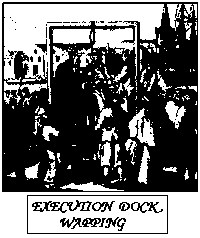 To stress the point
that a pirates crimes had been committed within the jurisdiction of the
Admiralty pirates were hanged at the low-tide mark at Wapping (above that mark
the civil courts took over).
To stress the point
that a pirates crimes had been committed within the jurisdiction of the
Admiralty pirates were hanged at the low-tide mark at Wapping (above that mark
the civil courts took over).
This term is used for pirates or privateers who operated in the Mediterranean. The most famous were the Barbary Corsairs from the Barbary Coast of North Africa (so called by the European crusaders who called their Muslim opponents barbarians) who were authorized by their governments to attack the shipping of Christian countries.
Less well known are the Maltese Corsairs who led the fight against the Turks, authorized by Knights of St. John. Initially they were driven by religion but after a while the rewards of piracy became paramount.
The term privateer could apply to an armed vessel, its captain or its crew. The main difference between a privateer and a pirate was that a privateer was authorized by a commission or a letter of marque from the government to capture the merchant vessels of a hostile nation.
A letter of marque was recognized by international law and, in theory, a privateer could not be charged with piracy. Maritime nations made use of privateers in times of war as a cheap way of attacking enemy shipping (saving the cost of building and maintaining a navy).
Originally hunters of cattle and pigs on the island of Hispanola (now Haiti and Dominica), buccaneers got their name from the French word boucan which means barbeque. This was because of the way they barbequed their meat on grills (as they had been shown by Arawak Indians).
Driven out by the Spanish, the hunters joined the groups of runaway slaves, deserters and others who preyed on the ships of the hated Spanish.By the end of the 17th century the word buccaneer was being applied generally to most of the pirates and privateers who had bases in the West Indies.
 Samuel
Bellamy - Black Bellamy
Samuel
Bellamy - Black Bellamy According to the legends preserved by the old timers on Cape Cod, Samuel Bellamy was a young English sailor who arrived in the new world colonies seeking fame and fortune. In 1715 he persuaded a wealthy patron to finance a ship and crew and sailed South to search for sunken Spanish treasure off the coast of Florida.
Treasure was not the only thing on young Bellamys mind as he promised local beauty Maria Hallet that he would return one day sailing the longest, tallest ship ever seen. He made no predictions on speed records, however, as he hoped the ship would be so laden with gold and silver.
The treasure hunt failed but Bellamy was loath to return to Massachusetts and Maria empty-handed, and the step to piracy was a small one. In little more than a year Samuel, now known as Black Bellamy, was captain of a notorious pirate crew that had plundered more than 50 ships.
One morning off Cuba, Bellamy and his buccaneers captured the Whydah, a 100-foot three-masted galley packed with ivory, indigo and thousands of silver and gold coins. Excited with his prize, he designated it as his flagship.
His fortune secured, Bellamy headed for home. By April 1717 he was off Cape Cod when his fleet was stuck by a stormy tempest completed with 70 mph gales and 40 foot tall waves. The Whydah was top heavy and highly susceptible to the driving winds blowing her ever closer to the shore. Amid scenes of mayhem the Whydah capsized, breaking her back with a heart-rendering crack.
Only two men survived the natural holocaust. One was an Indian pilot who quickly disappeared into the mists of history, the other Thomas Davis, a Welsh carpenter, whose vivid account of the shipwreck was preserved and passed from generation to generation through Cape Cod folklore.
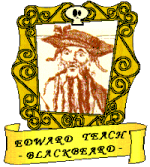 Edward
Teach - Blackbeard
Edward
Teach - Blackbeard
Thought to have been born in Bristol around 1680 Edward Teach (his official name although he used the aliases Thatch, Tash and Drummond) served as a seaman on privateers sailing out of Jamaica before turning to piracy in 1716.
He was made captain of a captured trading sloop whilst serving under the pirate Captain Benjamin Hornigold. The later capture of a French merchant ship the Concord provided Teach with his flagship which he renamed the Queen Annes Revenge. Famed for his alarming appearance, Teach had a thick, jet-black beard (the obvious source of his nickname) which was plaited and tied with ribbons. He went into battle with three pairs of pistols strapped across his chest, a number of daggers and pistols in his belt, a cutlass and a slow-burning fuses (made from thick hemp cord) tucked under his hat.
Teach maintained his cruel reputation by being as savage with his crew as he was with his prisoners. In his General History Captain Johnson tells a story of Blackbeard shooting his first mate Israel Hands at point-blank rangewhilst in his cabin having a drink. Hands was hit in the knee and crippled for life. Blackbeard explained
if he did not now and then kill one of them they would forget who he was.
Blackbeards pirate career was short-lived. In 1718 the Governor of Virginia, Alexander Spotswood, offered a £100 reward for the capture of Blackbeard - DEAD OR ALIVE!
He commissioned Lieutenant Robert Maynard of HMS Pearl who tracked Blackbeard down to one of his favoured anchorages at Ocracoke Inlet, North Carolina. After a confused and bloody battle in which Maynard engaged Blackbeard in a hand-to-hand fight on the deck of the pirate ship Blackbeard collapsed in a pool of blood with 20 cutlass wounds and 5 pistol shots. On seeing their captain fall the pirates surrendered.
Maynard had Blackbeards head cut off and returned for his reward with it hanging from the bowsprit of his ship. Blackbeards crew were tried in Virginia and all but one was found guilty and hung.
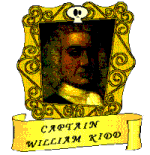 William Kidd
(c.1645 - 1701)
William Kidd
(c.1645 - 1701)
The notorious Captain Kidd was neither particularly ruthless nor successful. A New York merchant who had previously served as a privateer against the French in the West Indies,. He was commissioned in 1696 to hunt pirates but after a series of misfortunes began to raid vessels in the India Ocean.
He was arrested on his return to America in 1699 and sent to England to stand trial for piracy. Kidd bungled his own defence and vital documents were concealed by his former backers. He was hanged at Execution Dock and his body suspended in an iron cage of Tilbury Point for years as a warning to other seamen against piracy.
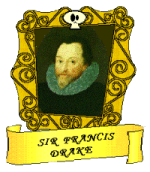 Sir Francis
Drake (c.1543 - 96)
Sir Francis
Drake (c.1543 - 96)A legendary privateer Drake was the first captain to take his own ship around the world. During his long career he made no more than seven voyages to the Spanish Main in search of treasure, adventure and revenge. One of his most famous exploits was the night attack on Nombre de Dios in 1572.
In 1577 - 80 he made the first circumnavigation of the world by an Englishman and returned with a cargo of splendid plunder taken from Spanish galleons and raids upon the coasts of Chile and Peru.
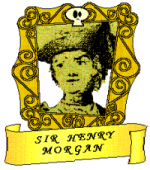 Sir Henry
Morgan (c. 1635 - 1688)
Sir Henry
Morgan (c. 1635 - 1688)Celebrated in ballads as the greatest of the buccaneers, Morgan was the leader of the Port Royal buccaneers in the late 1660s. His boldest exploit was the taking of Panama which was thought the wealthiest settlement of the New World in 1671. He subsequently became Deputy Governor of Jamaica.
Any woman who wanted to enter the mans world of piracy had to dress and behave like a man. The very nature of this deceit has meant that those who succeeded have passed unnoticed through history but there are a few cases in which the truth has come into light.
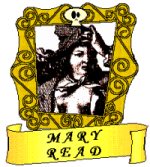 Mary Read
(died 1720)
Mary Read
(died 1720)Dressed in mens clothes Read had fought as a soldier in Flanders. Still dressed as a man, she sailed with Anne Bonny in the ship of John Calico Jack Rackham. At her trial in 1720 she escaped the death sentence by virtue of her pregnancy, but died of an illness shortly afterwards.
 Anne Bonny
Anne BonnyBonny was married to a penniles neer-do-well in the Bahamas when she met the swaggering Captain Calico Jack Rackham and joined his pirate ship dressed as a man. When their ship was attacked by a British Navy sloop off the coast of Jamaica in 1720 Bonny and fellow female pirate, Mary Read, drew their pistols and cutlasses and fought like demons.
The rest of the pirates, drunk on rum, cowered in the hold. Like Mary Read, she escaped the death sentence at her trial because she was pregnant. Nothing is known of her subsequent fate.
